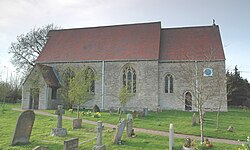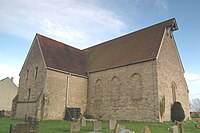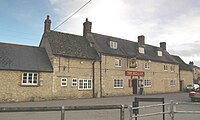Wendlebury
| Wendlebury | |
| Oxfordshire | |
|---|---|
 St Giles, Wendlebury | |
| Location | |
| Grid reference: | SP560195 |
| Location: | 51°52’19"N, 1°11’13"W |
| Data | |
| Population: | 421 (2011) |
| Post town: | Bicester |
| Postcode: | OX25 |
| Dialling code: | 01869 |
| Local Government | |
| Council: | Cherwell |
| Parliamentary constituency: |
Banbury |
| Website: | wendlebury.org.uk |
Wendlebury is a village in northern Oxfordshire, about two miles south-west of Bicester. A stream flows through the centre of the village, parallel with the main street.
The village is about half a mile from Junction 9 of the M40: Junction 9 is known as the Wendlebury Interchange.[1]
The 2011 census recorded the parish's population as 421.
The name of the village is from Old English, meaning the 'Wædel's fort'.[2]
Parish church
The earliest known record of the Church of England parish church, St Giles, is from early in the 13th century. It was cruciform until 1639, when the south transept was found to be so unsafe that it was demolished.[2]
In 1757 the remainder of the building was found unsafe and in March 1761 everything but the belltower was demolished. By September that year a new nave, chancel and two transepts had been completed, incorporating from the old church general building materials, early Decorated Gothic windows from about 1300[3] and a Perpendicular Gothic doorway.[2][3]
The foundations continued to give trouble and in 1901–02 the mediæval tower and 18th-century south transept were demolished. At the same time the architect John Oldrid Scott restored the remainder of the building,[3] renewing the roof and installing new seating. The tower had three bells: two cast in the 16th century and the third in 1695. Since the demolition of the tower these have stood in the west end of the nave.[2] The west gable of the nave now has a bell-cot with one bell.
The Old Rectory was built in 1840, replacing an earlier house that had existed by 1634.[2]
History
Before the Norman conquest in the 11th century one Asgar held the manor. After the Conquest, William the Conqueror granted Wendlebury to Geoffrey de Mandeville. The manor remained with his heirs, including his grandson of the same name whom King Stephen made 1st Earl of Essex in about 1140. It remained with the family until the de Mandeville line ended n 1227.
At the time of the Hundred Rolls in 1279, Thame Abbey held five virgates of land at Wendlebury. The abbey seems to have disposed of this land before 1317, as an inventory of its estates at that time makes no mention of Wendlebury. Rewley Abbey was founded in 1281 and by 1293 held at Wendlebury eight virgates of arable land plus twenty acres of meadow.[2] Rewley retained this minor estate until the Dissolution of the Monasteries in the 16th centuries, when it passed to Thomas Pope of Wroxton Abbey.[2]
The present manor house was built in the 17th century and remodelled in the 18th century.[3]
Wendlebury's one public house, the Red Lion, was built in the 17th century and seems to have been trading as an inn by 1732. In 1790 a farmer from Merton started a brewery in the village but the business failed and in 1809 was put up for sale. A Bicester brewer bought it in 1820.[2]
The common lands of the parish were inclosed in 1801 by Act of Parliament: 1160 acres were enclosed, of which 500 acre were awarded to the lord of the manor, Thomas Coker.[2]
The Oxford to Bletchley railway, completed in 1851 as part of the Buckinghamshire Railway, passes through the parish. The London and North Western Railway took over the Buckinghamshire Railway in 1879 and opened Wendlebury Halt southeast of the village in 1905. The Railways Act 1921 made the LNWR part of the new London, Midland and Scottish Railway, which closed Wendlebury Halt in 1926. The line's nearest station to Wendlebury is now Bicester Village, two miles away.
Outside links
| ("Wikimedia Commons" has material about Wendlebury) |
References
- ↑ "A34 M40 J9 Wendlebury Interchange". https://www.roads.org.uk/motorway/a34/50.
- ↑ 2.0 2.1 2.2 2.3 2.4 2.5 2.6 2.7 2.8 Lobel 1959, pp. 338–346
- ↑ 3.0 3.1 3.2 3.3 Sherwood & Pevsner 1974, p. 832.
- Henig, Martin (1990). "A Silver Ring from the Wendlebury Area". Oxoniensia (Oxfordshire Architectural and Historical Society) LV: 167–169. http://oxoniensia.org/volumes/1990/notes.pdf#page=1.
- A History of the County of Oxford - Volume 6 pp 338-346: Parishes: Wendlebury (Victoria County History)
- Nikolaus Pevsner: The Buildings of England: Oxfordshire, 1974 Penguin Books ISBN 978-0-300-09639-2page 832

